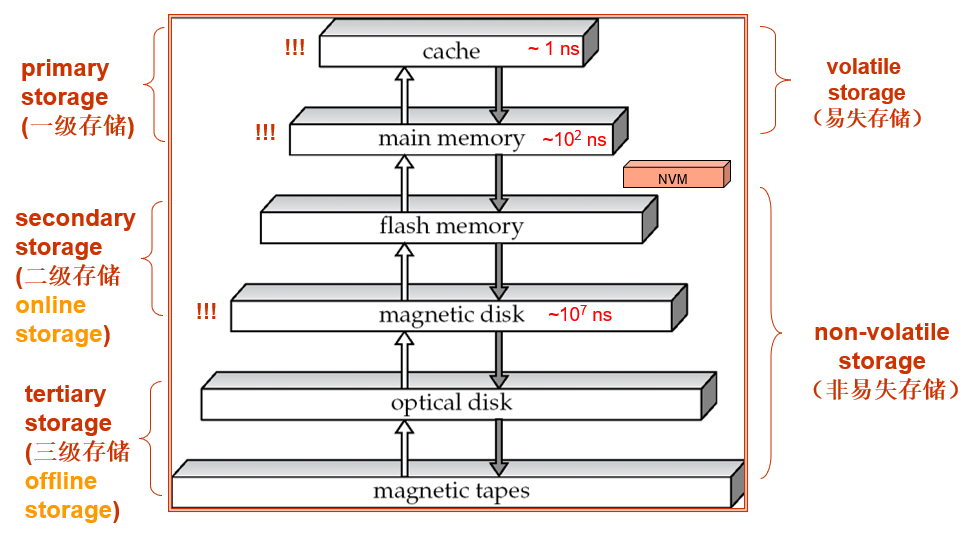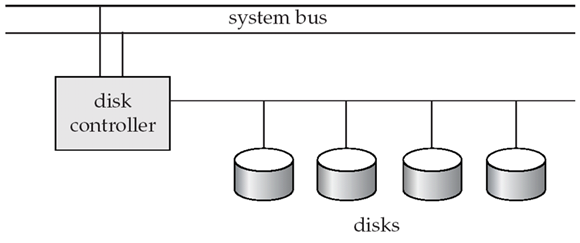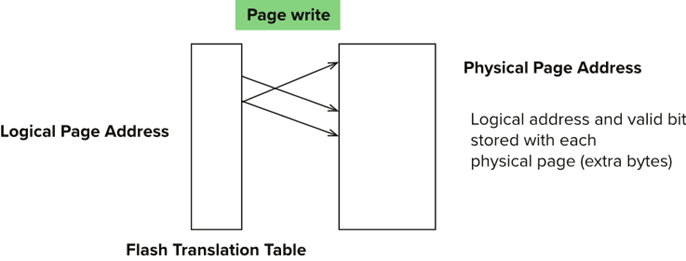Chapter 9 Classification of Physical Storage Media¶
Abstract
- Storage Hierarchy
- Magnetic Disks
- Disk Interface Standards
- Performance Measures of Disks
- Optimization of Disk-Block Access
- Flash Storage & SSD
- Storage Class Memory(NVM)
Classification of Physical Storage Media¶
- Can differentiate storage into:
- volatile storage(易失存储): loses contents when power is switched off
- non-volatile storage(非易失存储):
- Contents persist even when power is switched off.
- Includes secondary and tertiary storage, as well as batter- backed up main-memory.
- Speed with which data can be accessed
- Cost per unit of data
- Reliability
- data loss on power failure or system crash
- physical failure of the storage device
Storage Hierarchy(存储级别)¶

- primary storage: Fastest media but volatile (cache, main memory).
- secondary storage: next level in hierarchy, non-volatile, moderately fast access time
- also called on-line storage
- E.g. flash memory, magnetic disks
- tertiary storage: lowest level in hierarchy, non-volatile, slow access time
- also called off-line storage
- E.g. magnetic tape, optical storage
Magnetic Disks(磁盘)¶
- Read-write head(读写头)
- Positioned very close to the platter surface (almost touching it)
- Reads or writes magnetically encoded information.
- Surface of platter divided into circular tracks(磁道)
- Over 50K-100K tracks per platter on typical hard disks
- Each track is divided into sectors(扇区).
- A sector is the smallest unit of data that can be read or written.
- Sector size typically 512 bytes
- Typical sectors per track: 500 to 1000 (on inner tracks) to 1000 to 2000 (on outer tracks)
- To read/write a sector
- disk arm swings to position head on right track
- platter spins continually; data is read/written as sector passes under head
- Head-disk assemblies
- multiple disk platters on a single spindle (1 to 5 usually)
- one head per platter, mounted on a common arm.
- Cylinder(柱面) i consists of ith track of all the platters
- Disk controller(磁盘控制器) – interfaces between the computer system and the disk drive hardware.
- accepts high-level commands to read or write a sector
- initiates actions such as moving the disk arm to the right track and actually reading or writing the data
- Computes and attaches checksums to each sector to verify that data is read back correctly
- If data is corrupted, with very high probability stored checksum won’t match recomputed checksum
- Ensures successful writing by reading back sector after writing it
- Performs remapping of bad sectors

Performance Measures of Disks¶
- Access time(访问时间)– the time it takes from when a read or write request is issued to when data transfer begins. Consists of:
- Seek time(寻道时间) – time it takes to reposition the arm over the correct track. (磁盘臂重定位)
- Average seek time is ½ the worst case seek time.
- 4 to 10 milliseconds on typical disks
- Rotational latency (旋转延迟)– time it takes for the sector to be accessed to appear under the head.
- Average latency is ½ of the worst case latency.
- 4 to 11 milliseconds on typical disks (5400 to 15000 r.p.m.)
- Seek time(寻道时间) – time it takes to reposition the arm over the correct track. (磁盘臂重定位)
- Data-transfer rate(数据传输率) – the rate at which data can be retrieved from or stored to the disk.
- 25 to 100 MB per second max rate, lower for inner tracks
- Multiple disks may share a controller, so rate that controller can handle is also important
- E.g. SATA: 150 MB/sec, SATA-II 3Gb (300 MB/sec)
- Ultra 320 SCSI: 320 MB/s, SAS (3 to 6 Gb/sec)
- Fiber Channel (FC2Gb or 4Gb): 256 to 512 MB/s
- Disk block is a logical unit for storage allocation and retrieval
- 4 to 16 kilobytes typically
- Smaller blocks: more transfers from disk
- Larger blocks: more space wasted due to partially filled blocks
- 4 to 16 kilobytes typically
- Sequential access pattern(顺序访问模式)
- Successive requests are for successive disk blocks
- Disk seek required only for first block
- Random access pattern(随机访问模式)
- Successive requests are for blocks that can be anywhere on disk
- Each access requires a seek
- Transfer rates are low since a lot of time is wasted in seeks
- I/O operations per second (IOPS ,每秒I/O操作数)
- Number of random block reads that a disk can support per second
- 50 to 200 IOPS on current generation magnetic disks
- Mean time to failure (MTTF,平均故障时间) – the average time the disk is expected to run continuously without any failure.
- Typically 3 to 5 years
- Probability of failure of new disks is quite low, corresponding to a “theoretical MTTF” of 500,000 to 1,200,000 hours (57 to 136 years)for a new disk
- An MTTF of 1,200,000 hours for a new disk means that given 1000 relatively new disks, on an average one will fail every 1200 hours(50 days)
- MTTF decreases as disk ages
Optimization of Disk-Block Access¶
- Buffering: in-memory buffer to cache disk blocks
- Read-ahead(Prefetch): Read extra blocks from a track in anticipation that they will be requested soon
- Disk-arm-scheduling algorithms re-order block requests so that disk arm movement is minimized
- elevator algorithm

- File organization
- Allocate blocks of a file in as contiguous a manner as possible
- Allocation in units of extents (盘区)
- Files may get fragmented
- E.g., if free blocks on disk are scattered, and newly created file has its blocks scattered over the disk
- Sequential access to a fragmented file results in increased disk arm movement
- Some systems have utilities to defragment the file system, in order to speed up file access
- Nonvolatile write buffers (非易失性写缓存) – speed up disk writes by writing blocks to a non-volatile RAM buffer immediately
- Non-volatile RAM: battery backed up RAM or flash memory
- Even if power fails, the data is safe and will be written to disk when power returns
- Controller then writes to disk whenever the disk has no other requests or request has been pending for some time
- Database operations that require data to be safely stored before continuing can continue without waiting for data to be written to disk
- Writes can be reordered to minimize disk arm movement
- Non-volatile RAM: battery backed up RAM or flash memory
- Log disk(日志磁盘) – a disk
devoted to writing a sequential log of block updates
- Used exactly like nonvolatile RAM
- Write to log disk is very fast since no seeks are required
- No need for special hardware (NV-RAM)
- Used exactly like nonvolatile RAM
Flash Storage¶
- NAND flash - used widely for storage, cheaper than NOR flash
- requires page-at-a-time read (page: 512 bytes to 4 KB)
- Not much difference between sequential and random read
- Page can only be written once
- Must be erased to allow rewrite
- requires page-at-a-time read (page: 512 bytes to 4 KB)
- SSD(Solid State Disks)
- Use standard block-oriented disk interfaces, but store data on multiple flash storage devices internally

- Erase happens in units of erase block
- Takes 2 to 5 milliseconds
- Erase block typically 256 KB to 1 MB (128 to 256 pages)
- After 100,000 to 1,000,000 erases, erase block becomes unreliable and cannot be used
- Remapping of logical page addresses to physical page addresses avoids waiting for erase
-
Flash translation table tracks mapping
- also stored in a label field of flash page
- remapping carried out by flash translation layer

-
wear leveling(磨损均衡)- evenly distributed erase operators across physical blocks
Storage Class Memory(NVM)¶
- 3D-XPoint memory technology pioneered by Intel
- Available as Intel Optane
- SSD interface shipped from 2017
- Allows lower latency than flash SSDs
- Non-volatile memory interface announced in 2018
- Supports direct access to words, at speeds comparable to main-memory speeds
- SSD interface shipped from 2017
